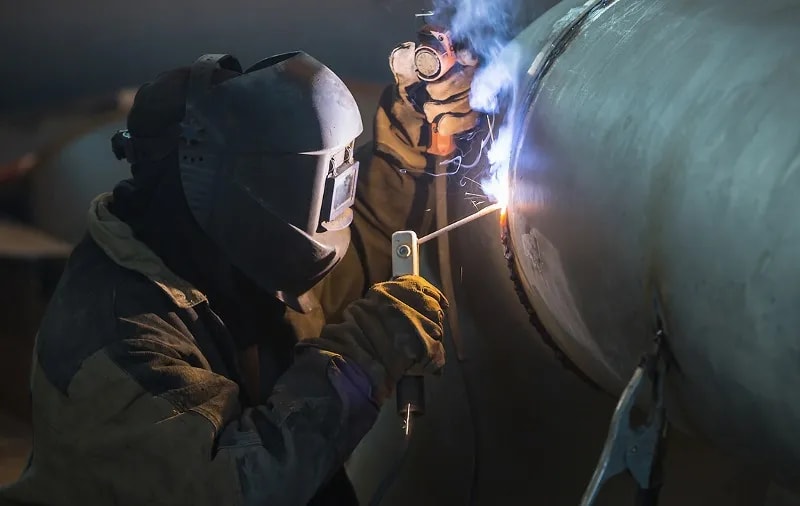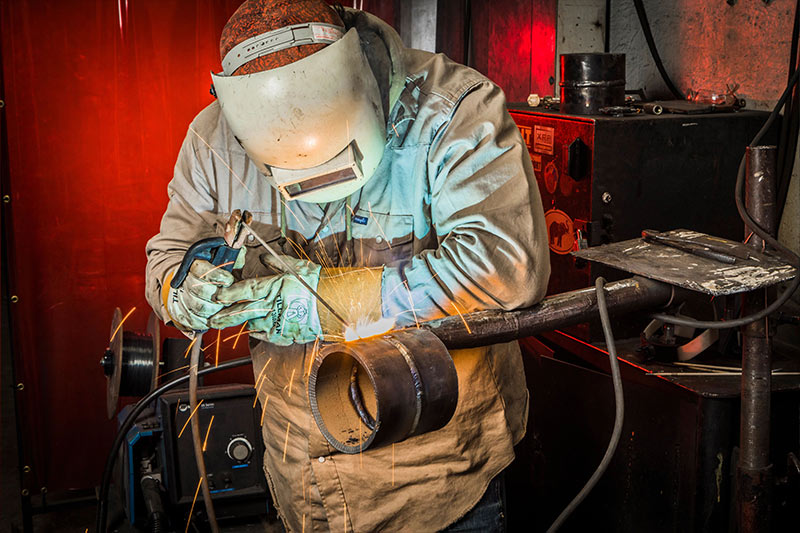Usual Welding Repair Issues and Exactly How to Address Them Properly
Welding repairs commonly run into a series of problems that can threaten the integrity of the final product. Common problems include insufficient penetration, porosity, and misalignment, to name a few. Each issue provides unique challenges that require particular methods for resolution. Recognizing these issues is vital for welders aiming to enhance their results and skills. This conversation will check out these typical welding repair problems and effective methods to resolve them.
Poor Infiltration
Poor infiltration occurs when the weld steel falls short to totally fuse with the base material, resulting in weak joints and prospective structural failures. This problem typically originates from not enough warmth input, inaccurate electrode angle, or improper welding speed. Welders may experience inadequate infiltration because of a miscalculation of the required specifications for a particular material thickness or kind. Furthermore, contamination on the base product's surface can hinder efficient bonding, exacerbating the trouble. To attend to inadequate penetration, welders should guarantee suitable settings on their tools and keep a clean job surface area. Regular examination of welds is recommended to recognize any shortages early, permitting prompt corrections and the avoidance of compromised structural honesty in welded settings up.
Porosity
Porosity is an usual problem in welded joints that shows up as little gas bubbles trapped within the weld steel. This problem can jeopardize the integrity of the weld, leading to minimized toughness and prospective failure under tension. Montana Mobile Welding and Repair Belgrade. Porosity typically arises from contamination, moisture, or incorrect welding methods, which enable gases to escape into the liquified weld swimming pool. To deal with porosity, welders ought to assure correct surface area preparation, preserve a tidy workplace, and utilize appropriate welding specifications. Additionally, picking the ideal filler material and shielding gas can minimize gas entrapment. Normal evaluation and testing of welds can aid recognize porosity early, assuring timely restorative activities are taken, consequently preserving the top quality and dependability of the welded framework
Imbalance
Misalignment in welding can arise from various aspects, including improper setup and thermal expansion. Recognizing the source is vital for efficient resolution. A number of modification strategies are available to realign parts and ensure architectural honesty.
Reasons for Misalignment
Welding misalignment usually stems from a selection of underlying issues that can endanger structural stability. One primary reason is inappropriate fit-up of components before welding, which can bring about gaps and uneven surface areas. Variants in thermal expansion during the welding process can additionally cause distortion, particularly if the materials being joined have different coefficients of development. Additionally, poor fixturing and securing may stop working to hold parts securely in location, causing activity throughout welding. Poorly conserved devices, consisting of welding machines and devices, may present disparities in the weld grain, more adding to misalignment. Lastly, driver mistake, stemming from inadequate training or experience, can additionally play a substantial duty in developing misaligned welds.
Adjustment Strategies Available
Resolving misalignment effectively requires a mix of corrective methods customized to the details issues at hand. One common method is making use of components or jigs to hold parts in the appropriate setting during welding, making certain regular placement. Additionally, pre-heating the materials can aid lower distortion and improve fit-up. For substantial misalignment, mechanical realignment techniques, such as using hydraulic jacks or clamps, can be employed to deal with the setting before welding. Post-weld warm therapy might additionally be required to ease stresses triggered by imbalance. Lastly, cautious inspection and adjustment during the arrangement phase can stop imbalance concerns from coming to be considerable problems, promoting a smoother welding process and enhancing overall structural stability.
Distortion
Distortion is a common challenge in welding that can emerge from numerous factors, consisting of uneven cooling and heating. Comprehending the reasons for distortion is crucial for applying reliable avoidance techniques. Resolving this issue not only improves architectural honesty but likewise enhances the total high quality of the weld.
Reasons of Distortion
When based on the extreme warmth of welding, products typically undertake adjustments that can result in distortion. This phenomenon mostly occurs from thermal expansion and contraction throughout the welding procedure. As the weld area warms up, the product increases; upon air conditioning, it acquires, which can develop inner stresses. Furthermore, irregular heating throughout a workpiece can intensify these anxieties, resulting in warping or bending. The kind of material likewise plays a substantial function; metals with differing thermal conductivity and coefficients of development might respond in different ways, leading to uncertain distortions. Inadequate joint layout and poor fixturing can contribute to imbalance during welding, raising the likelihood of distortion. Comprehending these causes is important for reliable welding repair work and avoidance strategies.
Avoidance Techniques
Reliable prevention techniques for distortion throughout welding emphasis on regulating warmth input and ensuring correct joint style. Maintaining a constant warmth input helps to reduce thermal growth and contraction, which can lead to distortion. Making use of techniques such as preheating the work surface can also reduce the temperature gradient, advertising uniform heating. In addition, selecting proper joint designs, such as T-joints or lap joints, can improve stability and lower anxiety concentrations. Applying appropriate fixturing to safeguard the work surfaces in position further aids in maintaining alignment throughout the welding process. Staggered welding series can distribute warm extra evenly, stopping local distortion. By applying these methods, welders can greatly reduce the possibility of distortion and boost the total high quality of their welds.
Breaking
Breaking is an usual problem run into in welding fixings, frequently arising from different variables such as incorrect air conditioning rates, product choice, or inadequate joint prep work. The incident of splits can considerably endanger the stability of the weld, leading to possible failures during procedure. To address this issue, welders must initially evaluate the source, ensuring that products work and appropriately selected for the certain application. In addition, managing the cooling price during the welding procedure is essential; quick cooling can generate stress and lead to fracturing. Proper joint layout and prep his response work also add to reducing the threat. Carrying out these techniques can enhance weld high quality and sturdiness, inevitably decreasing the possibility of fracturing in completed weldments.

Incomplete Blend
A considerable concern in welding fixings is insufficient fusion, which takes place when the weld steel does not sufficiently bond with the base product or previous weld passes - Montana Mobile Welding and Repair Fabrication. This issue can cause important site weaknesses in the joint, potentially endangering the integrity of the welded framework. Aspects contributing to incomplete blend consist of not enough heat input, improper welding method, and contamination of the surface areas being joined. To address this concern effectively, welders should ensure correct pre-weld cleaning and surface area preparation, along with change their welding criteria to attain appropriate infiltration and combination. Regular evaluation throughout the welding process can additionally aid determine insufficient fusion early, enabling prompt restorative actions to enhance the total high quality of the weld
Overheating
While welding repair work can improve structural stability, overheating provides a considerable difficulty that can bring about product deterioration. Excessive heat during welding can modify the mechanical homes of steels, leading to decreased strength, enhanced brittleness, and warping. This phenomenon is especially vital in high-stress applications where architectural dependability is critical. Identifying overheating can involve visual inspections for staining or distortion, along with keeping track of temperature throughout the welding procedure. To alleviate the risks connected with getting too hot, welders need to use proper strategies, such as regulating heat input, adjusting traveling speed, and utilizing ideal filler products. Furthermore, applying pre- and post-weld warm therapies can help restore product homes and enhance the total top quality of the repair, making certain lasting efficiency and security.
Often Asked Inquiries
What Are the Common Signs of a Welding Problem?

How Can I Examine My Welds for Top quality?
To examine welds for top quality, one can utilize aesthetic assessments, ultrasonic screening, and radiographic approaches. Each method guarantees structural stability, determines issues, and validates adherence to defined requirements, ultimately improving the integrity of the welded joints.
What Safety and security Precautions Should I Take While Welding?
When welding, one need to focus on security by using ideal personal safety equipment, making sure proper air flow, protecting flammable materials away, keeping a tidy work space, and being conscious of surroundings to avoid accidents and injuries.
Can I Repair a Weld Without Renovating the Entire Joint?
Repairing a weld without remodeling the whole joint is feasible, depending upon the damages (Montana Mobile Welding and Repair Fabrication). Methods such as find out grinding, adding filler material, or using a welding process can successfully attend to specific problems while maintaining the surrounding structure
What Equipment Are Vital for Efficient Welding Services?
Crucial devices for effective welding repairs include a welding machine, wire brush, grinder, protective gear, clamps, and filler products. Each device plays an important role in making certain top quality and safety and security during the repair process. Porosity typically arises from contamination, dampness, or incorrect welding strategies, which allow gases to get away into the molten weld pool. Badly maintained devices, consisting of welding makers and devices, may introduce variances in the weld grain, additional contributing to misalignment. When subjected to the intense warmth of welding, materials usually undertake modifications that can lead to distortion. Splitting is an usual issue encountered in welding repairs, typically resulting from various factors such as inappropriate cooling rates, material option, or poor joint preparation. A considerable problem in welding repair work is insufficient blend, which happens when the weld steel does not adequately bond with the base material or previous weld passes.